Landmarks Tournai
Spacer ulicami miasta może zająć kilka godzin, podczas których poznamy piękne kościoły, najstarsze romańskie kamienice, XIII-wieczny most na rzece Skalda oraz wiele innych pięknych zabytków i pomników. Po zwiedzeniu dwóch największych atrakcji Tournai, jakimi są bez wątpienia wpisane na Listę Światowego Dziedzictwa UNESCO wspaniała Katedra Najświętszej Marii Panny oraz dzwonnica, warto pozostać jeszcze na rynku głównym starego miasta. Można tutaj zobaczyć interesujący kościół św. Kwintyna oraz sukiennice.
Church of St. Quentin
The nave of this church, built in the Romanesque style, dates back to the end of the 12th century. The transept and presbytery, with a diagonal rib vault, are an example of the transition from the Romanesque to the Gothic style. The chancel is surrounded by 17th-century marble balustrades. The central tower was built in the 13th century. Originally, this tower was decorated with a double triforium (in Romanesque and Gothic buildings a window or a slide separated by columns into three parts and closed with a triple arcade), but during the Second World War it was destroyed by German bombing. It was rebuilt in a slightly changed shape.
Two round chapels are located in the angles formed at the junction of the nave and transept. One of them houses the tomb of Jaques Castaigne, who died in 1327. The second is where Pasquier Grenier, who contributed to the restoration of the tapestries in Tournai, is buried. The organ in the church was made by Delmotte in 1986.
Cloth Hall
This building on the market square was built in the 13th century of wood. However, after it was completely destroyed in 1606, it was rebuilt in 1610-1611 from stone. Different styles are combined here. The ground floor of the façade, decorated with triangular arches, is pure Gothic, the first floor is renaissance, and the top is baroque. The courtyard with internal galleries was built in 1616, similar to the Italian courtyards. Like most of the buildings on the square, the cloth hall also suffered from bombing in 1940. The facade of the building was renovated in 1998. Exhibitions and important events are held here today.
Za kościołem św. Kwintyna przy ulicy Rue Perdue znajdziemy dwie atrakcje:
Pierwsza to pomnik dziewczynki o imieniu Martynka z pieskiem. Są to postaci z komiksu, bardzo popularnego w Belgii w latach 60. Rysowali go dwaj belgijscy rysownicy Marcel Marlier i Gilbert Delahaye.
Druga to Czerwony Fort, średniowieczny budynek noszący nazwę od koloru dachu. Zbudowano go pod koniec XIII wieku z wapienia. Ma trzy poziomy, z których jeden został wyposażony w salę projekcyjną, w której można obejrzeć 10-minutowy film w cieniu murów obronnych. Fort ma średnicę 12 metrów. W 2003 roku został odrestaurowany.
Pierwsza to pomnik dziewczynki o imieniu Martynka z pieskiem. Są to postaci z komiksu, bardzo popularnego w Belgii w latach 60. Rysowali go dwaj belgijscy rysownicy Marcel Marlier i Gilbert Delahaye.
Druga to Czerwony Fort, średniowieczny budynek noszący nazwę od koloru dachu. Zbudowano go pod koniec XIII wieku z wapienia. Ma trzy poziomy, z których jeden został wyposażony w salę projekcyjną, w której można obejrzeć 10-minutowy film w cieniu murów obronnych. Fort ma średnicę 12 metrów. W 2003 roku został odrestaurowany.
Church of St. Jacob
Located on Rue Palais Saint-Jacques, the temple was built in 1167. The central nave, side aisles and the transept come from the first half of the 13th century. They are an example of a typical Gothic style. In 1368, the chancel was expanded, adding two side chapels. The chapel's ceiling on the right is decorated with paintings of angels playing instruments. They were painted in 1405, and in 1895 restored by the painter Jules Helbig. In the presbytery there is a lectern with the figure of an eagle from 1411. It is one of the few works of art that managed to survive an iconoclast attack on the church in 1566.
Tournai Central Station
The building is located on Place Crombez. It was built in 1879. The plans were created by architect Henri Beyaert. The King of Belgium, Leopold I, appeared at the official opening ceremony of the station. The glass roof of the station, which is 118 meters long, was destroyed during the bombing of the city during World War II.
Pont des Trous
Na nadbrzeżu Andrei Sakharowa (Quai Andrei Sakharov) znajduje się wspaniały most kamienny z XIII wieku. Pont des Trous, bo tak brzmi jego nazwa, to jeden z trzech istniejących współcześnie wojskowych mostów rzecznych. Jest on jednym z najbardziej prestiżowych śladów średniowiecznej architektury obronnej w Belgii. Był częścią tzw. drugich murów obronnych, w skład których wchodziło 18 bram. Jego zadaniem była obrona przejścia do Tournai od strony rzeki Skaldy. Budowa mostu trwała około 50 lat. Wieża Bourdiel, stojąca na lewym brzegu, pochodzi z 1281 roku. Wieża Thieulerie, stojąca po prawej stronie, została wybudowana 1304 roku. Podniesienie łuków zajęło kolejne 25 lat. Współcześnie pod mostem przepływają barki oraz łodzie.
Tenement houses from the 13th century
There are two magnificent Romanesque buildings on Barre Saint Brice. They were built in the years 1175-1200. The windows are formed by two horizontal rows of stones, supported by a monolithic column. They are prototypes of Flemish stone architecture and are among the oldest residential buildings of this type in Europe. Next to it there is a tenement house in the style of Louis XIV.
Przy tej samej ulicy znajduje się również gotycki budynek z XV wieku. W kamienicy tej wykorzystano architektoniczne wzorce, które były stosowane jeszcze w domach w stylu romańskim. Inne gotyckie budynki znajdziemy przy Rue des Jesuites. Pochodzą one z XIII wieku.



























